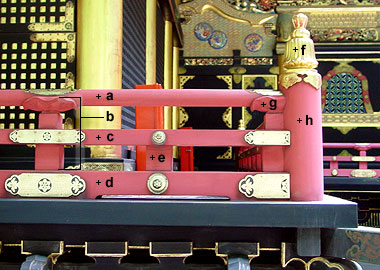Also called karayou kouran 唐様高欄. A railing
or balustrade *kouran 高欄
with features characteristic of the Zen 禅 style. The most easily identified is the
newel post *giboshi 擬宝珠,
which has an inverted, stylized lotus flower *gyakuren 逆蓮, with a tapered stem that extends upward or has petals that are slightly flared
with a bulbous form on top. Newer posts also have upright, half-opened, simplified
lotus patterns or one atop the other holding an undecorated bulbous form. The
top railings are supported by carved lotus leaf struts *kayouzuka 荷葉束. When used on altars *shumidan 須弥壇, the top rail *hokogi 架木, often slopes downward in an elongated curve toward the center front. When
compared to Japanese style *wayou 和様 railings, the Zen style railings are conspicuous for the use of ornamentation and curvilinear
forms.
Examples: Engakuji *Shariden 円覚寺舎利殿 in Kanagawa prefecture, Rinnouji Taiyuuin
*Reibyou 輪王寺大猷院霊廟 (1653) in Tochigi prefecture, Buttsuuji Ganki-in Jizoudou 仏通寺含暉院地蔵堂 (1407) in Hiroshima prefecture. |



